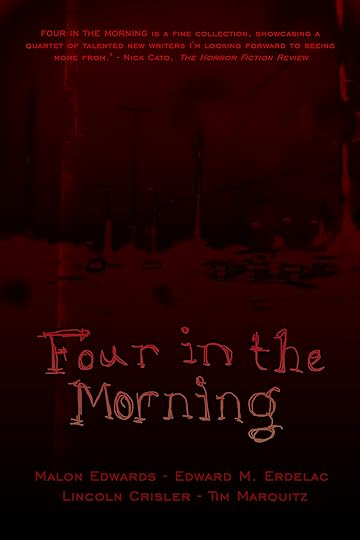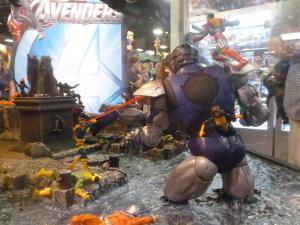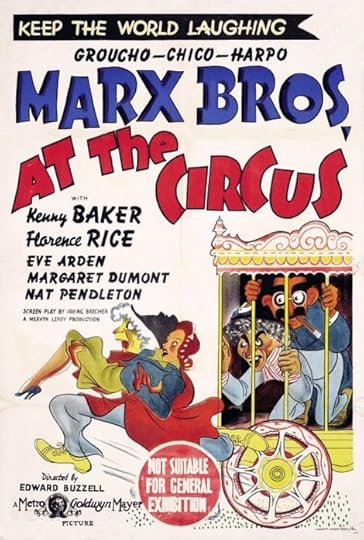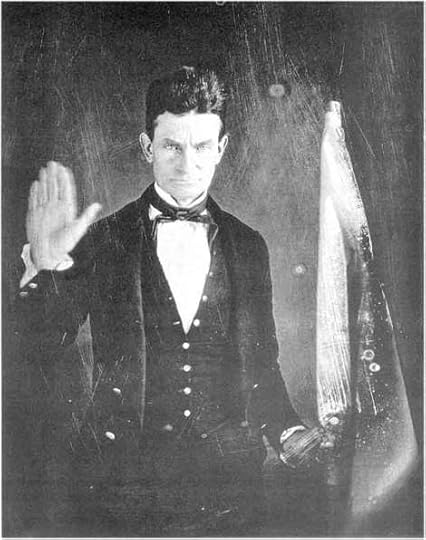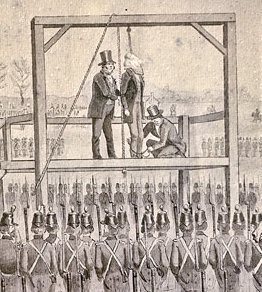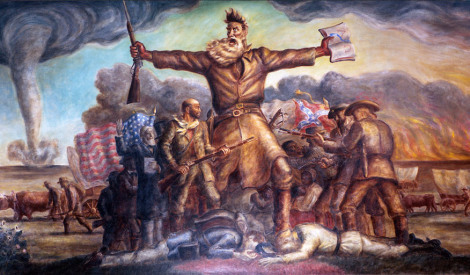Edward M. Erdelac's Blog, page 34
August 16, 2012
Batman Is Jesus For Atheists
…and author Jeff Strand thinks an altruistic Underdog is pretty unlikely.
Part 2 of Gef Fox’s roundtable discussion of Lincoln Crisler’s dark superhuman anthology Corrupts Absolutely from Damnation Books, which features my short story Conviction.
http://waggingthefox.blogspot.com/2012/08/capes-cowls-and-credibility-round-table.html?spref=tw


August 15, 2012
“Pop culture is the new religion and comic book fans are the Pentacostals.”
As part of author Gef Fox’s look at Lincoln Crisler’s dark superhuman anthology Corrupts Absolutely? (in which my story Conviction appears – read about that here), part one of a new roundtable discussion is up over at his blog. Go take a look and see if I sound like I know what I’m talking about.
http://waggingthefox.blogspot.com/2012/08/me-and-my-superheroes-round-table-with.html
Hasta pronto!


August 14, 2012
Lincoln Crisler Talk Dark Superhumans And Corrupts Absolutely? With Author Gef Fox
Thought I’d reblog this one.
Author Gef Fox is talking about Lincoln Crisler’s dark superhuman anthology Corrupts Absolutely all this week over at his blog, so check out this interview and the previous (and forthcoming posts).
http://waggingthefox.blogspot.com/2012/08/blasphemous-to-some-refreshing-to.html
You can read in depth about my contribution, Conviction, right here.
Hasta pronto,
Ed


August 7, 2012
DT Moviehouse Review: Atlantis: The Lost Empire
Time once more for my blog feature, DT Moviehouse Reviews, in which I make my way alphabetically through my 200+ DVD/Blu-Ray collection (you can see the list right here) and decide if each one was worth the money. Today I take a look at Disney’s underrated animated film Atlantis: The Lost Empire.

(2001) Directed by Gary Trousdale and Kirk Wise
Written by Tab Murphy with Story credits including Kirk Wise, Gary Trousdale, Joss Whedon, Bryce and Jackie Zabel, and David Reynolds.
Tagline: Atlantis Is Waiting…
What it’s about:
In 1914, underappreciated scholar Milo Thatch (Michael J. Fox) seeks to carry on his deceased grandfather Thaddeus’ quest for the legendary lost city of Atlantis. He keeps getting dismissed as a fringe academician until he is contacted by an old colleague of his grandfather’s, wealthy eccentric Preston Whitmore (John Mahoney), who recruits Milo to advise a fully funded and outfitted submarine expedition to find Atlantis. The expedition is led by a motley team of mercenaries including Commander Rourke (James Garner), his femme fatale second in command Helga Sinclair (Claudia Christian), dynamite expert Vinny (Don ‘Fr. Guido Sarducci’ Novello), Doc Sweet (Phil Morris), plucky engineer Audrey Ramirez (Jacqueline Obradors), geologist Mole Molierre (Corey Burton), sardonic communications expert Wilhemina Packard (Florence Stanley), and irascible cook Cookie Farnsworth (Jim Varney, in his last major performance), as well as a virtual army of gun toting red shirts. After their sub is wrecked by a mechanical submarinal guardian, Milo and the mercs find themselves in the highly advanced society of Atlantis, led by King Nedakah (Leonard Nimoy) and his daughter Princess Kida (Cree Summer). However, when Rourke comes face to face with the priceless secret energy source that had preserved Atlantis for 8,000 years, he shows his true colors and attempts to seize it for himself. It’s up to Milo and friends to stop him.
Why I bought it:
In 2001, this was the best animated movie I had seen since 1999’s sublime The Iron Giant.
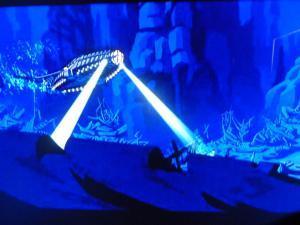 It’s a 50’s style sci-fi adventure movie in the vein of 20,000 Leagues Under The Sea and Journey To The Center Of The Earth, beautifully animated in top shelf Disney style, with fascinating, almost geometrical designs (notice the fingernails of all the characters are like diamond wedges) and conceptual work by Mike Mignola of Hellboy fame (particularly noticeable in the look of the gigantic Atlantean guardians).
It’s a 50’s style sci-fi adventure movie in the vein of 20,000 Leagues Under The Sea and Journey To The Center Of The Earth, beautifully animated in top shelf Disney style, with fascinating, almost geometrical designs (notice the fingernails of all the characters are like diamond wedges) and conceptual work by Mike Mignola of Hellboy fame (particularly noticeable in the look of the gigantic Atlantean guardians).
While it doesn’t have the emotional impact of The Iron Giant, it’s exciting and nostalgic in the same way, and there’s not a musical number in sight (but a great evocative age of discovery score), something refreshing in animated movies at the time, and a daring if sadly unsuccessful experiment by Disney.
The voice work is all top notch too. The character animations perfectly compliment the actors’ styles, mimicking even their body mannerisms at times (particularly in the case of Milo/Michael J. Fox). Aside from the stars and the swan song performances of the always great Jim Varney and Florence Stanley, the minor characters are diverse and interesting to watch.
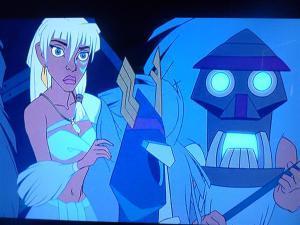 As a history buff, I was particularly impressed by all the cool background stuff casually dropped in the character of the African American Dr. Strongbear Sweet, who mentions growing up on an Indian reservation with a father in the famous 10th Cavalry (The original Buffalo Soldiers) and being present with the Rough Riders at the charge up San Juan Hill (the 10th was also at San Juan Hill). “I’ve got a sheepskin from Howard U and a bearskin from Old Iron Cloud.”
As a history buff, I was particularly impressed by all the cool background stuff casually dropped in the character of the African American Dr. Strongbear Sweet, who mentions growing up on an Indian reservation with a father in the famous 10th Cavalry (The original Buffalo Soldiers) and being present with the Rough Riders at the charge up San Juan Hill (the 10th was also at San Juan Hill). “I’ve got a sheepskin from Howard U and a bearskin from Old Iron Cloud.”
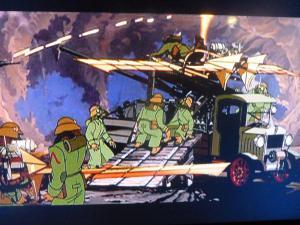
How cool is that?
Every frame of this movie displays an obvious love of craftsmanship and design. The movie is packed with period detail and seamlessly mixes real technology with fantastic steampunk-y inventions. Besides the Nautilus-esque submarine, I particularly liked the truck with a catapult that launched the motorized one man gliders.
In addition, the Atlantean stuff is superbly well realized, from the architecture and the retro-tech flying machines based off the sleek designs of sea creatures, right down to the invented language (there’s a neat little short on the development of that on the DVD special features).
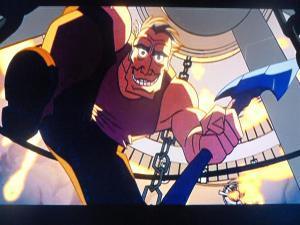
Rourke is like Gaston’s abusive father.
I’ve heard complaints about the story and single dimensionality of the characters. I didn’t see it personally. It’s a fun movie, action packed. The good guys are likable and relatable and the bad guys (particularly James Garner, who even pitches his beautiful lieutenant off a balloon to her death to lighten the load) are suitably ruthless. There are even a number of permanent deaths (including a whole slew of gas mask wearing red shirts) which really surprised me at the time.
As in all good adventure movies, the stakes are necessarily high.
Best bit of dialogue:
Most of Jim Varney’s dialogue cracks me up. He reminds me of a John Ford stock character. The one I keep thinking of is after an attack on the camp by fireflies (literally giant flaming flies). Cookie gets singed in the backside and drops trou, declaring;
“Dang lightning-bugs done bit me on my sit-upon! Somebody’s gonna have to suck out this poison. Don’t everybody jump up at once.”
Best scene:
Actually the entire climactic sequence takes the cake for me.
After Princess Kida melds with the power source of Atlantis (alternately described as living and sentient and as the collective will of all Atlanteans, but definitely containing the spirits of members of the royal family it has previously merged with) and is transmogrified into some kind of brilliant blue water elemental being, Rourke and Helga (and an army of red shirts) decide to take her to the surface and sell her to highest bidder (the Kaiser is alluded to).
Milo uses the Atlantean power crystals to get the flying machines running and takes off in pursuit with a contingent of Atlantean warriors and the rest of the mercenaries, whose consciences get the better of them after Rourke murders King Nedakah.
What follows is a thrilling subterranean aerial battle between the Atlantean craft and Rourke’s mechanical gliders, full of plasma blasts and chattering Maxim machineguns, and ending with an explosion that immolates the paralyzed Helga and sends a crystallized Rourke (he is transformed horribly by a scratch from one of the power crystals) smashing into the fan of a crashing balloon.
 The explosion also triggers a dormant underwater volcano which threatens to envelop Atlantis, until Princess Kida calls on the power source to activate a series of gigantic mystic stone automatons which rise from their 8,000 year slumber to erect a protective energy shell over the city against the avalanche of magma.
The explosion also triggers a dormant underwater volcano which threatens to envelop Atlantis, until Princess Kida calls on the power source to activate a series of gigantic mystic stone automatons which rise from their 8,000 year slumber to erect a protective energy shell over the city against the avalanche of magma.
It’s a sweeping, exciting sequence in the tradition of the best kind of pulpy adventure.
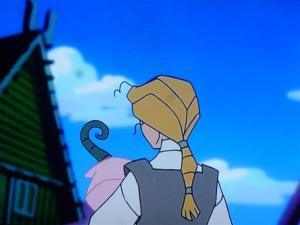 Would I buy it again? Yes. Also of note, Disney intended to produce an ongoing television series involving Milo and Kida (and the good mercenaries) searching the globe for Atlantean artifacts. After the movie flopped at the box office, these plans were abandoned, and the three produced episodes were put together and released as Atlantis 2: Milo’s Return. It’s too bad the show didn’t go through, because the three episodes are enjoyable excursions to different parts of the globe and delve into different mythologies (native American and Norse). The first episode involves a seaside town that makes a bargain with a sea monster – it’s EXTREMELY Lovecraftian in tone, an obvious homage, particularly when you consider the excised end postscript scene (which is still viewable on the DVD special features), which features a woman asking her unseen baby for a hug and having a wormy tentacle emerge from the bunting!
Would I buy it again? Yes. Also of note, Disney intended to produce an ongoing television series involving Milo and Kida (and the good mercenaries) searching the globe for Atlantean artifacts. After the movie flopped at the box office, these plans were abandoned, and the three produced episodes were put together and released as Atlantis 2: Milo’s Return. It’s too bad the show didn’t go through, because the three episodes are enjoyable excursions to different parts of the globe and delve into different mythologies (native American and Norse). The first episode involves a seaside town that makes a bargain with a sea monster – it’s EXTREMELY Lovecraftian in tone, an obvious homage, particularly when you consider the excised end postscript scene (which is still viewable on the DVD special features), which features a woman asking her unseen baby for a hug and having a wormy tentacle emerge from the bunting!
NEXT IN THE QUEUE: Attack The Block


July 22, 2012
Lincoln Crisler’s QUEEN in FOUR IN THE MORNING
 Lincoln Crisler is the last guy you’d expect to write a middle aged woman fretting over her age lines.
Lincoln Crisler is the last guy you’d expect to write a middle aged woman fretting over her age lines.
Scratch that. Lincoln Crisler is the last guy you’d expect to write a middle aged woman fretting over her age lines so well.
The guy is active duty military, tattooed, and can just about quiet a room (or I imagine a lineup of guys in OD green – do they still wear that?) with his voice. His clipped, direct speech reminds me of a drilling precision cadence. He’s not a hardass or anything. The guy is quite affable. But he really is the live action GI Joe his website trumpets him as.
But man, he writes the woefully vulnerable, self-deprecating middle aged female psyche really well.
And you know how I can tell? Because I hated Rita (the main character of Lincoln’s Queen in Four in the Morning, the collection my novella Gully Gods appears in, along with works by Tim Marquitz and Malon Edwards) when I met her. But I couldn’t stop reading about her. That’s the mark of a good author and a good story, and Lincoln Crisler and Queen are both.
In Queen, Rita is obsessed with herself and her husband’s opinion of her. She’s a beautiful, mature woman, but she requires constant positive appraisal, and rebuffs it or is nearly oblivious to it when it actually comes her way. The woman can’t seem to just live her own life or fathom that her husband has a life outside of her. This drives every event of the narrative, from her decision to rejuvenate herself via an experimental age reversal treatment conducted by a shady, too-friendly pharmaceutical company, to her husband James’ inevitable conduct and the supremely bizarre conclusion.
The woman is a heavenly body (slowly made all the more heavenly by the helpful Dr. Cavelian) and the people around her are just satellites. It’s fitting really. In a way, she’s already a queen in her own mind when the story starts, albeit not the sort of queen you’d want running your kingdom.
This is a Lincoln Crisler yarn, so things are going to take a weird turn, and they do. But for the eventual strangeness and horror to be believable, you’ve got be grounded in the reality first, and Lincoln does this really well. Although I couldn’t stand Rita, I could follow and empathize with her thought processes, could almost predict her reactions to things around her. I wanted to shake her at times, but I understood her.
 The treatment has side effects unforeseen by Rita, but not entirely unintended. And I don’t want to spoil anything, but there is a scene in the kitchen, and you’ll know when you come to it, that is positively stomach turning. And yet, none of it is so strange that it comes out of left field or feels non-diagetic. In fact, although Rita’s fate is somewhat tragic, it’s also sort of…appropriate. Everything comes together, culminating in a fitting end. In a way, Rita becomes the queen she always wanted to be, even if she didn’t know it herself.
The treatment has side effects unforeseen by Rita, but not entirely unintended. And I don’t want to spoil anything, but there is a scene in the kitchen, and you’ll know when you come to it, that is positively stomach turning. And yet, none of it is so strange that it comes out of left field or feels non-diagetic. In fact, although Rita’s fate is somewhat tragic, it’s also sort of…appropriate. Everything comes together, culminating in a fitting end. In a way, Rita becomes the queen she always wanted to be, even if she didn’t know it herself.
In the end, what Lincoln’s created in Queen is a dark meditation on the nature of beauty and self-worth. You’re only as important as the people closest to you think you are. But it’s a reciprocal thing. To be needed, you have to need in return.
And as for beauty, it really only starts to fade when you dwell on it.
Here’s an excerpt -
Something moved, deep in her belly, accompanied by a brief flash of heat behind her eyes. She eased her head back to her pillow. If the doctor wanted her to avoid unnecessary stress, that meant playing dead until James took his ass to work. She lay still and focused on her breathing while her husband heaved himself out of bed and started his day. The hot flashes and queasiness passed, and after a moment, she didn’t have to fake sleep.
A sharp pain ripped through Rita from crotch to skull, waking her abruptly. She looked over at the clock as she struggled to raise herself up on one elbow. She’d slept until lunchtime. Fire and ice washed over her brain. Her legs felt like rubber as she attempted to stand. She fell to her knees beside the bed and pawed at the nightstand, scattering the clock and a cup of water before laying hands on what she was searching for; her cell phone. It was dead. There was no land line in the house, and she was alone.
The neighbors. The two nearest homes belonged to the Moores and the Clares. The Clares were childless and both worked, but blonde, bright-eyed Susan had retired early a few months back when her daughter started college. If she wasn’t home, her daughter, Jordan, might be. Otherwise, she’d have to cross the street and hope she didn’t get run over. Rita braced herself against the nightstand and rose to her feet. Her guts churned and static filled her head. She could hear voices through the haze, but couldn’t make out any of the words. The lurching in her stomach became rhythmic, and her hips ground painfully. Watery blood flooded from her vagina as she fell to the floor.
Oh God. What did those assholes do to me? She was in worse pain than she’d ever been in before. She crawled to the bathroom on her hands and knees, trailing fluid and mucus. She needed to clean herself up, get some pants on, and get some help. As she left the carpet for the hard, cool tile of the bathroom floor, she felt the first familiar sensation she’d felt all morning.
Birth contractions. Far too soon, but undeniable.
Pick up Four In The Morning on Amazon.


July 17, 2012
In Teh Realms Of Teh Unreal: San Diego Comic Con 2012
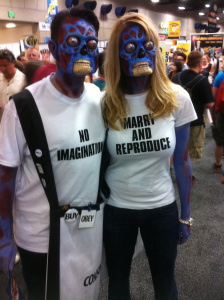
Fortunately, we had plenty of bubblegum.
Not a whole lot of news to report on my trip to San Diego Comic Con this year.
Brought three writing samples and didn’t pass out nary a one, to my detriment. My friends and I had a late start and I narrowly missed connecting with the IDW editor I had acquainted myself with at WHC. I’m terrible at just cold-approaching people for the most part, something I’m working at getting over.
Most of the day was spent traversing the huge exhibit hall and shopping for presents for my kids. Wound up with one of those plushie Wonder Womans for my middle daughter and a Poison Ivy t-shirt for the eldest (she likes Poison Ivy because she’s into gardening).
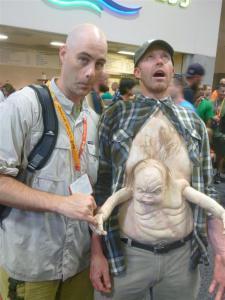
Open your miiinnnnd, Mr. Carter
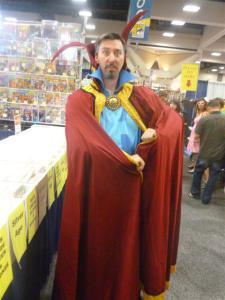
My favorite costume of the con.
Of note, there was a seriously intense pair of sprawling action figure dioramas at the Hasbro booh I had to stop and take a few appreciative pics of.

Snake Eyes and Jinx battle ninjas.
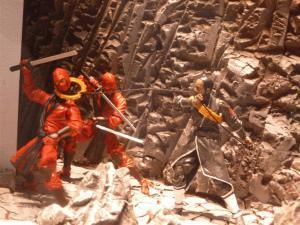
Yes – that is a flying guillotine.
I did manage to connect with author and friend Alice Henderson. We had a decent dinner, marred by an unseasonal chill and obnoxious fellow diners (sorry, Alice – you pick next time). We adjourned to the Hilton later and had drinks and talked with Warhammer authors Nathan Long and Mike Lee, as well as Chelsea Monroe-Cassel and Sariann Lehrer, the culinary experts behind the A Feast of Ice And Fire: The Official Game Of Thrones Companion Cookbook. Nice group of folks. A good time was had I think by all.

2AM on the streets of San Diego. Moments later I saw the Doctor.
Two AM rolled around and we took a pair of pedicabs back to the garage. I’ve never taken one of these things before, being content to walk usually, but given the lateness of the hour and the cuteness of the driver, I agreed. It turned out she was ashmatic, so my guilt was compounded, but we happened to pass another pedicab going the other way and saw the Doctor himself, Matt Smith, yucking it up in the back with a lady friend.So I guess it was worth her suffering?

Our much put-upon pedicab driver….I don’t know if we even tipped her, assholes that we are.
Next year, plotting a three day weekend to really take more advantage of things professionally.
Hasta pronto.


July 12, 2012
Fantasy Book Review Talks Up Merkabah Rider 2
Josh and Ryan over at Fantasy Book Review over in the UK (though they sound like Australians or New Zealanders to me so maybe I’m just going by the UK in the web address) talked up the Merkabah Rider series on their podcast, as a prelude to Ryan’s review of Merkabah Rider 2: The Mensch With No Name.
You can give it a listen over here – my bit starts at 56:28.
http://www.fantasybookreview.co.uk/fbrblog/fbr-cast-002-pirates-ahoy/
Hasta pronto,
Ed








July 11, 2012
DT Moviehouse Review: At The Circus
Time once more for my blog feature, DT Moviehouse Reviews, in which I make my way alphabetically through my 200+ DVD/Blu-Ray collection (you can see the list right here) and decide if each one was worth the money. Today I take a look at The Marx Brothers in At The Circus.

(1939) Directed by Edward Buzzell
Written by Irving Brecher
Tagline: Keep The World Laughing!
What It’s About:
Circus owner Jeff Wilson (Kenny Baker – not related to the guy who plays R2D2) has mustered up $10,000 in cash to pay off his partner John Carter (James Burke, no relation to John Carter of Mars), but Carter pulls a double cross and hires strong man Goliath (Nat Pendleton) and cigar chomping dwarf Atom (Jerry Maren of the Lollipop Guild in Wizard of Oz – still kicking at 92 as of this posting) to steal the money so he can gain control of the circus. Roustabouts Antonio (Chico Marx) and Punchy (Harpo Marx) enlist the aide of shyster lawyer J. Cheever Loophole (Groucho Marx) to help get Jeff’s money back.
Why I Bought It:
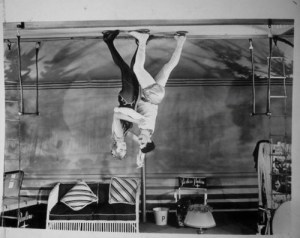 I actually didn’t buy this one, it was a Christmas gift, part of a Marx Brothers DVD collection.
I actually didn’t buy this one, it was a Christmas gift, part of a Marx Brothers DVD collection. 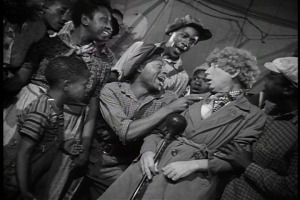 This is not my favorite Brothers outing. Much of it is a little blah. Part of the reason is the reliance on sometimes overly complex (for the Marx Brothers anyway) physical comedy situations, a direct result of the studio’s hiring the legendary Buster Keaton to work for scale as a gag man. Keaton is a genius, but his style of comedy and the Brothers’ just doesn’t mix very well. The set ups should be very funny (Groucho walking on the ceiling in suction boots with the lovely Eve Adren, Goliath’s acrobat girlfriend), a guy in a gorilla suit, a high falootin’ orchestra getting cast adrift on a floating band shell, etc, but they don’t pan out somehow.
This is not my favorite Brothers outing. Much of it is a little blah. Part of the reason is the reliance on sometimes overly complex (for the Marx Brothers anyway) physical comedy situations, a direct result of the studio’s hiring the legendary Buster Keaton to work for scale as a gag man. Keaton is a genius, but his style of comedy and the Brothers’ just doesn’t mix very well. The set ups should be very funny (Groucho walking on the ceiling in suction boots with the lovely Eve Adren, Goliath’s acrobat girlfriend), a guy in a gorilla suit, a high falootin’ orchestra getting cast adrift on a floating band shell, etc, but they don’t pan out somehow.
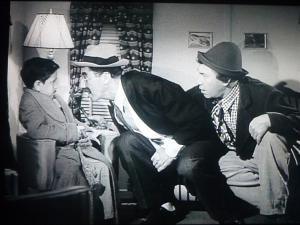 That said, there are a couple very funny scenes, including the Brothers knocking over Jerry Maren’s small-sized furniture and hitting their heads on his low ceiling (and Groucho’s repeated attempts to procure one of the dwarf’s cigars – ‘Say, do you happen to have a spare cigar?’ – only to be constantly undermined by Chico, who somehow always has a spare cigar in his coat), the usual excellent wooing banter between Groucho and the put upon but perennially loaded Margaret Dumont, and a hilarious bit where Harpo and Chico search the sleeping strongman’s room for the money and end up cutting the guy’s blanket to ribbons while Harpo is inadverdantly drugged.
That said, there are a couple very funny scenes, including the Brothers knocking over Jerry Maren’s small-sized furniture and hitting their heads on his low ceiling (and Groucho’s repeated attempts to procure one of the dwarf’s cigars – ‘Say, do you happen to have a spare cigar?’ – only to be constantly undermined by Chico, who somehow always has a spare cigar in his coat), the usual excellent wooing banter between Groucho and the put upon but perennially loaded Margaret Dumont, and a hilarious bit where Harpo and Chico search the sleeping strongman’s room for the money and end up cutting the guy’s blanket to ribbons while Harpo is inadverdantly drugged. 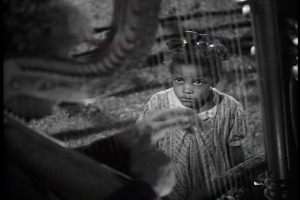 There are a couple of pretty funny lines (Chico hands a wrinkled telegram in to be sent and the clerk says ‘Is this a straight wire?’ Chico: ‘Nah, I think I bent it up a little.’), and a nice Harpo musical number sung with an all African American ensemble (including Dudley Dickerson, the eternally scared overweight guy that appeared later in several Three Stooges outings), Swingali, that’s worth mentioning because a of a beautiful rendition of Blue Moon he plays on the harp, to the apparent awe of one very photogenic little girl.
There are a couple of pretty funny lines (Chico hands a wrinkled telegram in to be sent and the clerk says ‘Is this a straight wire?’ Chico: ‘Nah, I think I bent it up a little.’), and a nice Harpo musical number sung with an all African American ensemble (including Dudley Dickerson, the eternally scared overweight guy that appeared later in several Three Stooges outings), Swingali, that’s worth mentioning because a of a beautiful rendition of Blue Moon he plays on the harp, to the apparent awe of one very photogenic little girl.
The love story is even more incidental than usual. I don’t even remember what happens to Jeff’s fiance, and I just watched this last night.
Best Dialogue:
Goliath’s girlfriend Peerless Pauline has been rebuffing Groucho’s advances until she decides she can throw him off her boyfriend’s case.
Pauline: You know, last night I decided something. You’re the man I’ve been dreaming of.
Groucho: What do you eat before you go to bed?!
Best Scene:
There is one scene that elevates At The Circus above its relative mediocrity, one of the classic scenes of all cinema. Funny enough, it’s a musical number, which is not something Marx Brothers comedies are generally known for.
But early in the movie Groucho sings Lydia The Tattooed Lady in a crowded dining car as his brothers caper about and swing from the chandelier. It’s just one of the most joyous and fun sequences ever committed to film. Great song (including a reference to Captain Spaulding, Groucho’s character from Animal Crackers), great rendition, great performance. Judge for yourself. But my two year old little girl stared singing ‘Lydia O Lydia’ while I watched this.

Would I Buy It Again? Tough call. I love Lydia, but I could probably watch it on Youtube. This has it’s moments, but I don’t think I would have purchased it myself. I’d save my money for Duck Soup.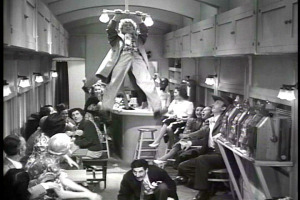
Next Up In The Queue: Atlantis: The Lost Empire








July 5, 2012
My Favorite American Was A Terrorist
In honor of Independence Day, I decided to write a bit about one of my all-time favorite Americans, who happened to have been, for all intents and purposes, a terrorist (much like one of my other heroes, Geronimo).
I’m talking about ‘Ossawatomie’ John Brown, the man Herman Melville called “the meteor of the [civil] war.”
Many more qualified people can argue the finer points of the causes of the American Civil War. They may say it was the last throes of agrarian society against the industrial revolution, or the assertion of the invidual represented by the southern states against the conglommerate, as characterized by the northern union, and there may something to say for all of these arguments.
But the plain fact of the matter is, whatever the myriad of causes that lead up to it, the powder keg was set off because of slavery, as clear cut a case of right vs. wrong as the Allies vs. the Axis.
And the hand that lit the match was John Brown’s.
Brown was born in Connecticuit in 1800, the son of Owen Brown, the founder of Oberlin College in Ohio.
He was raised in a strict Cavinist household. The Calvinist Christian doctrine teaches that the natural state of man is wicked depravity, that his very nature makes him incapable of redemption or ascendence to the divine. Only with God (and this is the concept known as sovereign grace) can a man find redemption. This is, not by individual merit or effort; God has chosen from all of eternity, an Elect few who are predestined from birth to receive grace and reward. The rest will be subject to God’s wrath. This has the effect (I believe) of putting a man on constant eggshells. If every soul that will receive reward is already accounted for, how does one know if, when they die, they will go to heaven or hell? They don’t. If a man lives a worthy life, it is because God wills it. And only he knows at the end of his life if he was one of the Elect. The same goes for a wicked man. If a man does evil, he is in his natural state. If that same man repents and becomes a righteous person, it is because he was one of the Elect all along, unless he’s only paying lip service to appear good, in which case he was damned all along anyway and is just play acting for whatever reason.
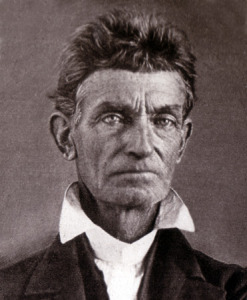 Now I write about this to try to give you a sense of what went into the volatile mixture that was John Brown.
Now I write about this to try to give you a sense of what went into the volatile mixture that was John Brown.
In addition to this unique religious upbringing, he was a poor tanner’s son, in a region of the united states where the native population outnumbered the whites. As a result, he grew up in buckskins and counted native boys among his best friends. What effect this had on the racial notions of young John Brown can only be guessed, but he was raised in a fiercely abolitionist household. Now most northerners were nominally abolitionists, that is, they were opposed to the idea of slavery.
Brown had first hand experience with it.
Mainly self reliant, by the age of twelve he drove a herd of his father’s cattle to Michigan and stayed at the house of a family friend. There he observed a black boy his age savagely beaten with an iron shovel and made to sleep in the cold wearing only rags and tatters. In his own words, this made him “swear eternal war on slavery.”
In 1837, after trying and failing at numerous business ventures, Brown and the rest of the country bore witness to an escalation in pro-slavery and abolitionist conflict when the Reverend Elijah P. Lovejoy, an outspoked abolitonist minister who published an anti-slavery paper called The Alton Observer (perhaps unwisely, in the midst of the pro-slavery town of Alton, Illinois, which was a known base for slave catchers), was gunned down by a pro-slavery mob.
Upon hearing of the murder in church at an anti slavery meeting, Brown rose from his pew and announced to the congregation;
“Here, before God, in the presence of these witnesses, from this time, I consecrate my life to the destruction of slavery.”
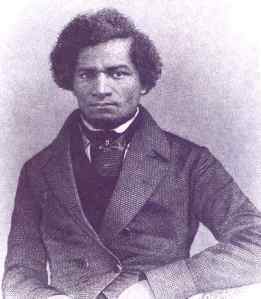
Frederick Douglass
He spent four years in Springfield, Massachussetts, trying his hand at the wool trade and helping to establish the city as a major stop on the Underground Railroad. Commiserating with fellow abolitionists, he befriended prominent African Americans of the time like Sojourner Truth and Frederick Douglass, the latter of which said, after dining and sleeping in Brown’s home,
“…while I continued to write and speak against slavery, I became all the same less hopeful for its peaceful abolition. My utterances became more and more tinged by the color of this man’s strong impressions.”
Thereafter, relocated Brown family (he had fathered twenty children on two women – his first wife had died) to the black community of North Elba in upstate New York, where he worked for several years to improve the conditions, and also ran a station on the Underground Railroad, ferrying escaped slaves up into Canada.
In 1854 the Kansas-Nebraska Act was passed, which opened the western territories of the same name to settlement, and left the question of whether Kansas would be admitted to the Union as a slave or free state up to the voting residents. This had the effect of inducing pro and anti slavery forces to send droves of settlers into the state to swell their respective ranks. In what became known as ‘Bleeding Kansas,’ sporadic armed conflicts began to erupt between the opposing factions. This was the civil war in its adolesence, with junior bushwhackers and jayhawkers playing out in miniature what would rage across the entire union in a few short years.
Among the anti-slavery residents, a few of Brown’s grown sons had settled and begun organizing and arming the abolitionist-minded settlers. Writing to their father of their concern for the safety of themselves and their families, the family patriarch responded by moving west, stopping along the way at several of his own haunts, soliciting money and arms from like-minded abolitionists (Brown carried crates of .54 Sharpes rifles hidden in crates marked ‘bibles’ – these became the so-called Beecher Bibles, named for prominent abolitionist Henry Ward Beecher). He and his sons became local leaders of the anti-slavery militia.
In May of 1856 three things conspired to bring the conflict to a head for Brown. His father died, the unofficial anti-slavery capitol of the territory, Lawrence, was sacked by pro-slavery ‘Border Ruffians’ under the sanction of a corrupt sheriff, and on the floor of the Senate, Charles Sumner of Massachussetts was beaten with a metal tipped cane by Senator Preston Brooks of South Carolina, after Sumner said in a scathing anti-slavery oration of Brooks’ relative Andrew Butler;
“Of course he has chosen a mistress to whom he has made his vows, and who, though ugly to others, is always lovely to him; though polluted in the sight of the world, is chaste in his sight. I mean the harlot Slavery (and went on to insinuate that pro-slavery senators were pimps and that the main southern cause for championing slavery was so the lecherous masters could force themselves on negro women).”
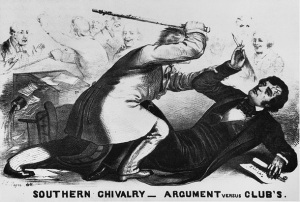
Southern Chivalry – the Caning of Senator Sumner
In a rage, Brown called together his sons and a few militia members and taking up broadswords and rifles, raided the homes of five pro-slavery settlers along the Pottawatomie Creek, dragged the men out into the night, hacked them to death, and shot them.
From then on, Brown and his sons became guerilla fighters, even raiding into Missouri to liberate slaves from the auction block. They clashed with Missouri militias, defending the Kansas settlement of Palmyra and turning back a superior force for a time at Ossawatomie (earning him the nickname ‘Ossawatomie Brown’). One of Brown’s sons, Frederick, was killed in the latter fight.
In late 1856, Kansas governor John W. Greary ordered an end to hostilities, offering amnesty to both sides upon the cessation of conflict. Brown and his surviving sons headed East to raise funds for the cause.
The cause, for Brown, possibly unbeknownst to some of his wealthy, pacifist backers, was to wage total war on the South and incite servile insurrection on a mass scale. Brown had been germinating this plan since his introduction to the Underground Railroad.
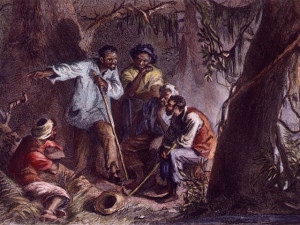
Nat Turner
For inspiration, he looked to Spartacus, the Thracian gladiator who trained and commanded an army of slaves against the Roman Empire, and to Nat Turner, the black preacher who in 1831 led 56 slaves in an armed uprising in Southhampton, Virgina which resulted in the deaths of 160 whites and blacks, and his own eventual capture and execution. Brown was also spiritually inflamed by the figure of Moses in Exodus (whose likeness he even took on in his later years, cultivating a long white beard) and Cinque, who led the slave mutiny on the Amistad.
His plan was to raid a federal arsenal of its stores, and march across the south, arming slaves and burning plantations as they went, looping up into the Adirondack Mountains to establish a free and separate colony of freed blacks.
After months of meeting and preparation, Brown gathered together a force of 18 men (including his sons Watson, Owen, and Oliver), including free blacks and one fugitive slave. Ready to enact his plan, he paid one last call on Frederick Douglass, asking him to come along to inspire the slaves to come to him. Douglass and Brown argued through the night, Douglass trying to convince his old friend that the plan was doomed to fail. In the end, he refused.
On October 16th Brown led his band into Harper’s Ferry, Virginia, and successfully and bloodlessly took the armory, cutting the telegraph wires and taking several wealthy landowners (including George Washington’s great grand nephew) hostage. Things took a turn for the worse however, when a black baggage master, Hayward Shepherd, was shot by one of the raiders and a train passed through the town, spreading word of the action to the surrounding countryside. Local militias descended on the town and began a firefight that lasted three days.
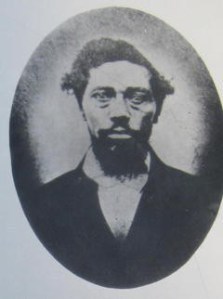
Dangerfield Newby
During the siege, Dangerfield Newby, a mulatto and the oldest of the insurrectionists, who had joined Brown in the hope of freeing his wife and children still in bondage in Warrenton, Virginia, was shot through the throat by a six inch spike (the town militia, unable to use the armory ammunition, was firing anything they could stuff down the barrels of their muskets). The enraged townsfolk mutilated his body, cutting off his arms and legs and taking his ears for souvenirs.On his body was found a note from his wife;
BRENTVILLE, August 16, 1859. Dear Husband.
I want you to buy me as soon as possible for if you do not get me somebody else will the servents are very disagreeable thay do all thay can to set my mistress against me Dear Husband you not the trouble I see the last two years has ben like a trouble dream to me it is said Master is in want of monney if so I know not what time he may sell me an then all my bright hops of the futer are blasted for there has ben one bright hope to cheer me in all my troubles that is to be with you for if I thought I shoul never see you this earth would have no charms for me do all you Can for me witch I have no doubt you will I want to see you so much the Chrildren are all well the baby cannot walk yet all it can step around enny thing by holding on it is very much like Agnes I mus bring my letter to Close as I have no newes to write you mus write soon and say when you think you Can Come
Your affectionate Wife HARRIET NEWBY
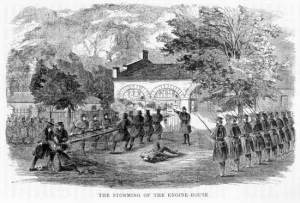 On the morning of the 18th, Brown and his remaining defenders and their hostages were surrounded in the town firehouse by the US Marines, commanded by Colonel Robert E. Lee, future General of the Confederate Army, and Lt. JEB Stuart, destined to win renown in the coming war. Under a white flag, Stuart parleyed with Brown, offering to spare his life if he surrendered. Both of his sons lying dead behind him, Brown declared “No, I prefer to die here.” Whereupon the Marines smashed the engine house foors with sledgehammers and charged in firing. Brown was wounded, and Lt. Israel Green, who had borne his dress sabre into battle, inadverdantly spared him when his blade bent on Brown’s belt buckle.
On the morning of the 18th, Brown and his remaining defenders and their hostages were surrounded in the town firehouse by the US Marines, commanded by Colonel Robert E. Lee, future General of the Confederate Army, and Lt. JEB Stuart, destined to win renown in the coming war. Under a white flag, Stuart parleyed with Brown, offering to spare his life if he surrendered. Both of his sons lying dead behind him, Brown declared “No, I prefer to die here.” Whereupon the Marines smashed the engine house foors with sledgehammers and charged in firing. Brown was wounded, and Lt. Israel Green, who had borne his dress sabre into battle, inadverdantly spared him when his blade bent on Brown’s belt buckle.
Of the 18 raiders, eleven were killed, three escaped, and four were captured and sentenced to hang.
Brown’s raid was a total failure.
Yet, in the last three months of his life, the attention of the world turned to his trial. I can only liken it to the importance of the Rodney King hearings. The entire world held its breath. The liberal minded could not fathom that America could allow Brown to be executed, and the south was enraged by the notion that a terrorist attack on American soil could possibly be expected to go unpunished.
Victor Hugo wrote letters urging Brown’s pardon. Predicting the civil war, he wrote,
“Let America know and ponder on this: there is something more frightening than Cain killing Abel, and that is Washington killing Spartacus.”
Henry David Thoreau likened him to Christ.
And Brown, despite his failure as a commander and businessman, did not fail in the last, to use the national attention he had engendered to speak out against slavery at every turn. In his cell, he responded to slews of letters and interviews, denouncing slavery as the greatest sin of the nation, and speaking out against slaveholders, pro-slavery politicians, and southern clergy who dared to condone the institution, whether directly or by inaction.
He comported himself magnificently at his trial. When his defense attorneys decided to plea insanity, Brown himself refused the motion. When he was sentenced to hang, he is recorded as saying;
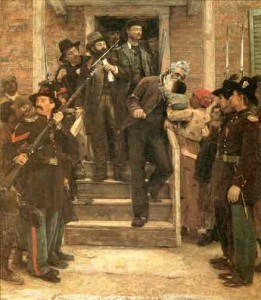 “Had I interfered in the manner which I admit, and which I admit has been fairly proved (for I admire the truthfulness and candor of the greater portion of the witnesses who have testified in this case), had I so interfered in behalf of the rich, the powerful, the intelligent, the so-called great, or in behalf of any of their friends, either father, mother, brother, sister, wife, or children, or any of that class, and suffered and sacrificed what I have in this interference, it would have been all right; and every man in this court would have deemed it an act worthy of reward rather than punishment.
“Had I interfered in the manner which I admit, and which I admit has been fairly proved (for I admire the truthfulness and candor of the greater portion of the witnesses who have testified in this case), had I so interfered in behalf of the rich, the powerful, the intelligent, the so-called great, or in behalf of any of their friends, either father, mother, brother, sister, wife, or children, or any of that class, and suffered and sacrificed what I have in this interference, it would have been all right; and every man in this court would have deemed it an act worthy of reward rather than punishment.
This court acknowledges, as I suppose, the validity of the law of God. I see a book kissed here which I suppose to be the Bible, or at least the New Testament. That teaches me that all things whatsoever I would that men should do to me, I should do even so to them. It teaches me, further, to “remember them that are in bonds, as bound with them.” I endeavored to act up to that instruction. I say, I am yet too young to understand that God is any respecter of persons. I believe that to have interfered as I have done as I have always freely admitted I have done in behalf of His despised poor, was not wrong, but right. Now, if it is deemed necessary that I should forfeit my life for the furtherance of the ends of justice, and mingle my blood further with the blood of my children and with the blood of millions in this slave country whose rights are disregarded by wicked, cruel, and unjust enactments, I submit; so let it be done.”
In the last months of his life, abolitionist conspirators and supporters of Brown planned and prepared to execute a rescue plan. When a former compatriot of Brown’s, Silas Soule (who would heroically go on to testify against the horrible Sand Creek Massacre of Cheyenne Indians in Colorado, and later be murdered for it), managed to infiltrate the prison and tell Brown of the plan, Brown flatly refused to be rescued. He had decided he would do more for the cause of abolition as a martyr than as a fugitive.
It’s this singularity of purpose that I can’t help but admire. Here was a man who rose up at precisely the right moment and became the lynchpin of history. Abraham Lincoln is remembered as freeing the slaves, but how could there be an Emancipation Proclamation without the Civil War, and how could there be a Civil War without the selfless actions of John Brown, a man who perceived a wrong so abominably terrible in American society that he couldn’t abide it, and was unwilling to simply wait out what most beleived would be a natural, gradual end.
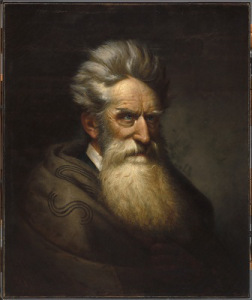 How could a man of that time step forward and put his life on the line for a people society taught were not his own? Was it his Calvinist sense of predestination? Or was it that he took all he had been taught, in terms of the laws of God and man, as serious and literal as it was meant to be? Why is John Brown a footnote in history, that the majority of people don’t even know about? Was it because he was a white man? I don’t believe his crusade was as much about race for him as it was about class oppression. Was it because his solution to a nationwide injustice perpetuated and accepted in society was violence?
How could a man of that time step forward and put his life on the line for a people society taught were not his own? Was it his Calvinist sense of predestination? Or was it that he took all he had been taught, in terms of the laws of God and man, as serious and literal as it was meant to be? Why is John Brown a footnote in history, that the majority of people don’t even know about? Was it because he was a white man? I don’t believe his crusade was as much about race for him as it was about class oppression. Was it because his solution to a nationwide injustice perpetuated and accepted in society was violence?
His favorite Bible passage after all was Hebrew 9:22 – And almost all things are by the law purged with blood; and without shedding of blood is no remission.
People called him insane, and fanatical. But in my mind he was the only sane man in an insane world. He was witness to one of the most barbarous and pernicious practices our country has ever visited upon human beings, and he saw it for precisely what it was, an abomination, an affront to everything America was intended to stand for. He was the man who stood up and said no to what most people were content to ride out or pretend wasn’t happening, or write a check for and forget about. The man took up arms in an unwinnable personal crusade, and sacrificed himself and his sons on the infamous altar of liberty, if ever any man did (“I could live for the slave,” Frederick Douglass wrote, “John Brown could die for him.”). If this is insanity, then the insane should be given freer rein in this world.
Interestingly, Malcom X said of John Brown, on this very day, in 1965;
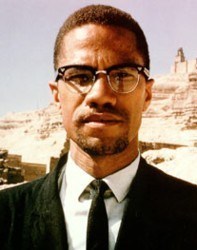 “You know what John Brown did? He went to war. He was a white man who went to war against white people to help free slaves. White people call John Brown a nut. Go read the history, go read what all of them say about John Brown. They’re trying to make it look like he was a nut, a fanatic. They made a movie on it, I saw movie on the screen one night [I assume this was Raymond Massey in either Seven Angry Men, or Santa Fe Trail - he played him twice] . Why, I would be afraid to get near John Brown if I go by what other white folks say about him. But they depict him in this image because he was willing to shed blood to free the slaves. And any white man who is ready and willing to shed blood for your freedom—in the sight of other whites, he’s nuts. . . .So when you want to know good white folks in history where black people are concerned, go read the history of John Brown. That was what I call a white liberal. But those other kind, they are questionable.”
“You know what John Brown did? He went to war. He was a white man who went to war against white people to help free slaves. White people call John Brown a nut. Go read the history, go read what all of them say about John Brown. They’re trying to make it look like he was a nut, a fanatic. They made a movie on it, I saw movie on the screen one night [I assume this was Raymond Massey in either Seven Angry Men, or Santa Fe Trail - he played him twice] . Why, I would be afraid to get near John Brown if I go by what other white folks say about him. But they depict him in this image because he was willing to shed blood to free the slaves. And any white man who is ready and willing to shed blood for your freedom—in the sight of other whites, he’s nuts. . . .So when you want to know good white folks in history where black people are concerned, go read the history of John Brown. That was what I call a white liberal. But those other kind, they are questionable.”
In reading about him, the sheer complexity of coincidence surrounding him is astounding. As he sat upon his coffin and was wheeled out to the gallows in the back of a wagon, 2,000 soldiers were amassed to secure the scene. Among them, amazingly, was another future Confederate hero, Stonewall Jackson, and an actor who had borrowed a militia uniform solely to attend the hanging. This man expressed satisfaction at the abolitionist traitor’s fate, but grudgingly admired Brown’s stoic courage when faced with his own mortality.
His name was John Wilkes Booth.
It’s as if all of history were poised about him.
Brown left a handwritten note with the executioner. It read;
“I, John Brown, am now quite certain that the crimes of this guilty land will never be purged away but with blood.”
He was right. Following his hanging, the outcry on either side of the spectrum was too intense and inflammatory to settle down. Southerners theorized that Brown’s bloody raid had been part of a Black Republican conspiracy to undermine the south. Why else would a white man risk his life to free slaves? The liberal north demonized the south as Pharisees enacting another crucifxion. The south was appalled at support for Brown’s actions, which they saw as traitorous. It was as if the entire Muslim population of America had come out for Osama Bin Laden (they didn’t, in case you didn’t know that). The first whispers of secession were heard.
And Frederick Douglass (who I think, may have turned the tide of Brown’s personal fate had he agreed to join him, for not a single Virginia slave flocked to his side) said famously;
“But the question is, did John Brown fail? Did John Brown draw his sword against slavery and thereby lose his life in vain? And to this I answer ten thousand times, No! No man fails who can so grandly give himself and all he has to a righteous cause. If John Brown did not end slavery, he did at least begin the war that ended slavery. When John Brown stretched forth his arm the sky was cleared. The time for compromises was gone -the armed hosts of freedom stood face to face over the chasm of a broken Union -and the clash of arms was at hand. The South drew the sword of rebellion and thus made her own, and not Brown’s, the lost cause of the century.”








June 28, 2012
Win A Signed Copy Of Buff Tea On Goodreads
 Hey all, for the summer I’m running a giveaway on Goodreads of my western novel Buff Tea from Texas Review Press.
Hey all, for the summer I’m running a giveaway on Goodreads of my western novel Buff Tea from Texas Review Press.
In 1874 a boy leaves a comfortable life in Chicago and heads west to work on the burgeoning railroad, quickly finding the labor not to his liking. He joins a disparate group of itinerant buffalo hunters led by a tough old ex-Indian fighter named War Bag Tyler and they pass into Texas to participate in the great slaughter. The season draws to a close and death strikes the outfit. War Bag swears a Cheyenne Dog Soldier from his past is responsible. As War Bag plots a new hunt, a hunt for the Cheyenne, the boy must choose between life and death.
You can read an excerpt right here -
http://emerdelac.wordpress.com/2011/06/11/buff-tea-an-excerpt/
And this will take you directly to the giveaway.
http://www.goodreads.com/giveaway/show/28249-buff-tea
Suerte!










